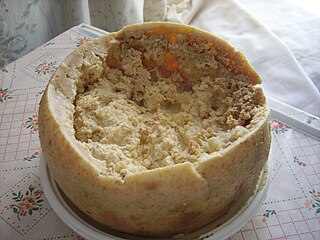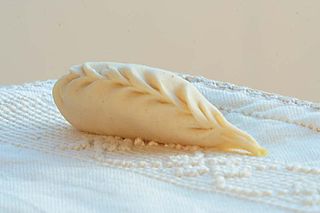| Pecorino | |
|---|---|
 | |
| Country of origin | Italy |
| Source of milk | Sheep |
| Texture | Hard |
| | |
Pecorino cheeses are hard Italian cheeses made from sheep's milk. The name "pecorino" derives from pecora, which means "sheep" in Italian. [1]
| Pecorino | |
|---|---|
 | |
| Country of origin | Italy |
| Source of milk | Sheep |
| Texture | Hard |
| | |
Pecorino cheeses are hard Italian cheeses made from sheep's milk. The name "pecorino" derives from pecora, which means "sheep" in Italian. [1]

Of the six main varieties of pecorino, all of which have protected designation of origin (PDO) status under European Union law, pecorino romano is probably the best known outside Italy, especially in the United States, which has been an important export market for the cheese since the 19th century. [2] Most pecorino romano is produced on the island of Sardinia, though its production zone also includes Lazio and the Tuscan provinces of Grosseto and Siena. Ancient Roman authors wrote about this cheese and its production technique. [3]
The other five mature PDO cheeses are the pecorino sardo from Sardinia (casu berbeghinu in Sardinian language); pecorino toscano , whose production was already attested by Pliny the Elder in his Natural History ; [4] pecorino siciliano (or picurinu sicilianu in Sicilian) from Sicily; pecorino di Filiano from Basilicata; [5] and pecorino crotonese from province of Crotone in Calabria. [6] Another well-known pecorino is the one that was produced in Abruzzo, the pecorino di Atri . [7] [8]
All come in a variety of styles depending on how long they have been aged. The more matured cheeses, referred to as stagionato ("seasoned" or "aged"), are harder but still crumbly in texture and have decidedly buttery and nutty flavours. The other two types, semi-stagionato and fresco, have a softer texture and milder cream and milk tastes.

A variant from Southern Italy is pecorino pepato (literally, "peppered pecorino"), to which black peppercorns are added. Today many other additions are made, for example walnuts, rocket, or tiny pieces of white or black truffle.
In Sardinia, the larvae of the cheese fly are intentionally introduced into pecorino Sardo to produce a local delicacy called casu martzu , which means "rotten cheese". As it is illegal, casu marzu is primarily sold through the black market. [9]
Meals may be finished with a good pecorinostagionato, served with pears and walnuts or drizzled with strong chestnut honey. Pecorino is also often used to finish pasta dishes, and used to be the natural choice for most Italian regions from Umbria down to Sicily, rather than the more expensive Parmesan. It is still preferred today for the pasta dishes of Rome and Lazio, for example pasta dressed with sugo all'amatriciana , cacio e pepe , and pasta alla gricia .

Mozzarella is a semi-soft non-aged cheese prepared by the pasta filata method with origins from southern Italy.

Pecorino romano is a hard, salty Italian cheese, often used for grating, made with sheep's milk. The name pecorino simply means "ovine" or "of sheep" in Italian; the name of the cheese, although protected, is a simple description rather than a brand: "[formaggio] pecorino romano" is simply "sheep's [cheese] of Rome".

Casu martzu, sometimes spelled casu marzu, and also called casu modde, casu cundídu and casu fràzigu in Sardinian, is a traditional Sardinian sheep milk cheese that contains live insect larvae (maggots).

Sugoall'amatriciana, or alla matriciana, also known as salsa all'amatriciana, is a traditional Italian pasta sauce based on guanciale, pecorino romano cheese, tomato, and, in some variations, onion. Originating from the town of Amatrice, the amatriciana is one of the best known pasta sauces in present-day Roman and Italian cuisine. The Italian government has named it a traditional agro-alimentary product of Lazio and amatriciana tradizionale is registered as a traditional speciality guaranteed in the EU and the UK.

Pecorino sardo is a firm cheese from the Italian island of Sardinia, made from sheep's milk, specifically from the milk of the local Sardinian breed. It was awarded denominazione d'origine status in 1991 and granted protected designation of origin protection in 1996, the year in which this European Union certification scheme was introduced.

The cuisine of Sardinia is the traditional cuisine of the island of Sardinia, and the expression of its culinary art. It is characterised by its own variety, and by the fact of having been enriched through a number of interactions with the other Mediterranean cultures while retaining its own identity. Sardinia's food culture is strictly divided into food from the land and food from the sea, reflecting the island's historical vicissitudes and especially its geographic landscapes, spacing from the coastline to the ragged mountains of the interior. The Sardinian cuisine is considered part of the Mediterranean diet, a nutritional model that was proclaimed by UNESCO as an intangible cultural heritage.

Pecorino toscano is a firm-textured ewe's milk cheese produced in Tuscany. Since 1996 it has enjoyed protected designation of origin (PDO) status.
Sardo is a hard, grating cow's milk cheese that is similar to Pecorino Romano.

Sheep milk cheese is a cheese prepared from sheep milk. Well-known cheeses made from sheep milk include the feta of Greece, Roquefort of France, manchego from Spain, the pecorino romano and ricotta of Italy. Yogurts, especially some forms of strained yogurt, may also be made from sheep milk.

Pecorino di Filiano is a firm cheese from the Italian region of Basilicata made from sheep milk. It was granted protected designation of origin (PDO) in 2007.

Granarolo S.p.A. is a food company in Italy founded in 1957 and based in Bologna. It operates in the fresh milk and dairy-cheese sector, dry pasta, deli meats and vegetable foods.
Red Pecorino is a red Sicilian cheese which was originally developed in Sicily, Italy. In Italian, it is referred to as "Picurinu Rusu". Red Pecorino is made from sheep's milk and Sicilian folate pastes in a technique known as pasta filata which is used in the manufacture of a family of Italian cheeses also known as stretched-curd, pulled-curd, and plastic-curd.

Culurgiones are a type of Sardinian ravioli-like stuffed pasta. It exists in a version made of potatoes, pecorino cheese and mint, a typical culinary specialty of the sub-region of Ogliastra, and in several other recipes adopted in the rest of the island, such as in Gallura, where the product is aromatized with lemon or orange peel.
Pecorino may refer to: